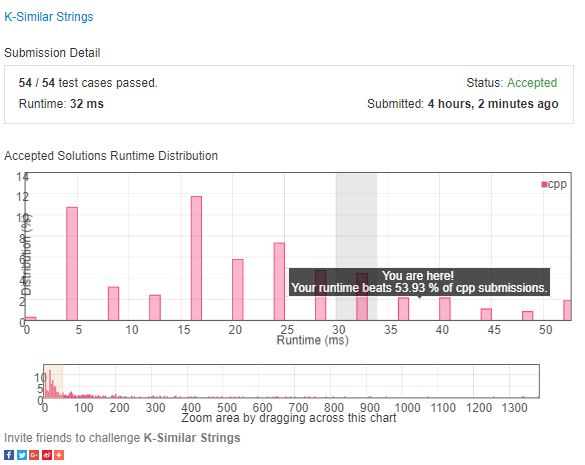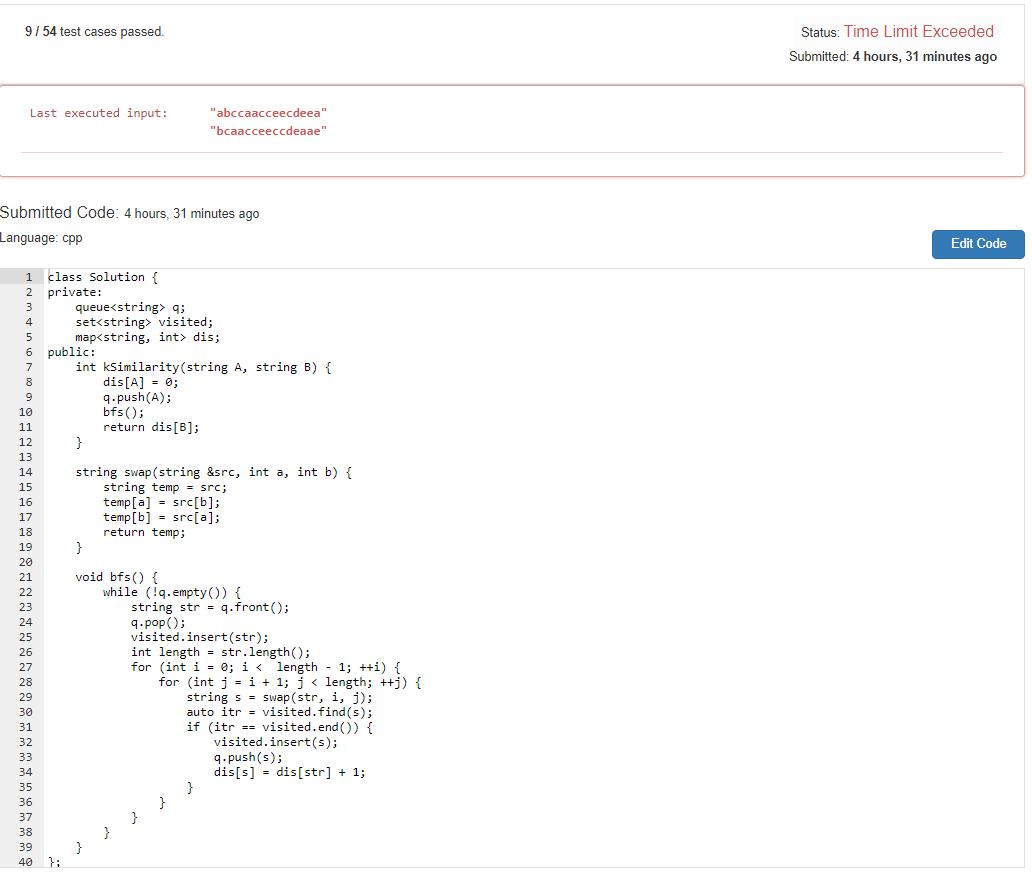Leetcode-Breadth-First-Search
K-SimilarStrings
Description
Strings A and B are K-similar (for some non-negative integer K) if we can swap the positions of two letters in A exactly K times so that the resulting string equals B.
Given two anagrams A and B, return the smallest K for which A and B are K-similar.
Note:
1 <= A.length == B.length <= 20
A and B contain only lowercase letters from the set {‘a’, ‘b’, ‘c’, ‘d’, ‘e’, ‘f’}
Example
- Example 1
Input: A = “ab”, B = “ba”
Output: 1 - Example 2
Input: A = “abc”, B = “bca”
Output: 2 - Example 3
Input: A = “abac”, B = “baca”
Output: 2 - Example 4
Input: A = “aabc”, B = “abca”
Output: 2
Analysis
题目意思很明确:给出两个字符串 A,B。如果字符串 A 中的字符,经过交换 k 次,可以得到字符串 B,则称 A 与 B 为 K 相似串。现给出 A,B,求最小的 K。
我们一步一步来分析。这是一个给定初始状态,计算到达目标状态的最短路径长度。查找最短路径的算法,我们用 BFS 算法。使用 BFS 算法,我们首先需要构造一张图。我们定义图的节点为字符串,节点的转换我们定义为字符串字符的swap(e.g.:节点 ab 通过交换 a 和 b 得到下一个节点 ba)。由此我们可以根据初始节点,通过 BFS 不停地生成(搜索)节点,查找达到目标节点的最短路径,也就是 K 值。我们举个 Example 例子来看看。
Example 2
Input: A = “abc”, B = “bca”
Output: 2
初始节点为 abc,可以经过 3 次不同的交换操作,生成(搜索)三个新节点,然后通过 BFS,可以在第二层搜索到目标节点,也得到最短路径2。
定义好了图的节点和节点转移方法,我们就可以写出第一版的 BFS了。我们来看看结果。大大的 TLE(23333)。
我们需要优化。我们在 BFS 中考虑了使用 visited 来标识访问过的节点,避免陷入死循环,实际上这对减少访问节点的个数,并没有太大的帮助。基础比较好的同学肯定知道,启发式搜索,这是可以帮助减少搜索节点个数,更快接近目标节点的进阶版 BFS。在这里,我们可以采取类似的思想,来减少搜索的节点个数。
我们可以模仿启发式搜索的思想来进行优化。我们对于当前搜索的节点,寻找其第一个与目标节点不匹配的字符,然后在这个字符后,寻找一个与目标节点匹配的字符进行交换,这样构造出来的节点,是我们继续搜索的节点。这样我们就大大减少了搜索的节点个数,因为交换后而没有向目标节点靠近的节点,会增加搜索层数,这必然不是在最短路径上的节点。这就是我们优化的核心思想。
Accept Picture
前面梯队的速度差异,主要是 STL 库函数的使用,第一梯队使用的 DFS,是很神奇的做法。

Code
1 | static int desyncio = []() { |
Another Idea
前面使用的优化是直接减少搜索的节点个数,我们还是可以利用启发式搜索的思路的。A*是常用的一种启发式搜索,主要是其中的代价函数,我们可以仿照代价函数,使用优先队列来对搜索节点进行排序,其中,定义正确字符个数越多的节点,优先级越高。这样也可以加快搜索的速度。
这只是一个想法,感知可行,至于真实性,留待考验。


